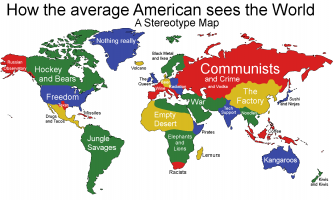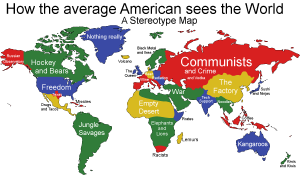This literary essay is written by one of my grade 10 students. She has stated a very clear thesis about unfair stereotypes, which are unfortunately present in all societies. She has included very clear quotes from the stories and the myths, showing how such stereotypes are challenged in literature. Finally, he makes an interesting observation about stereotyping. Instead of demonizing it, he points out that stereotyping is a survival technique that humans all possess; therefore, they need to learn not to use it unfairly.
Challenging Stereotypes
What is people’s first impression when they see a homeless person on the street? Most often, people will consider them as someone that is uneducated and probably addicted to drugs. However, that is not always the case. The person might, in fact, be an educated person, who never smokes cigarettes, but he or she might have ended up homeless on the streets due to unemployment. Considering all homeless people to be undereducated is stereotyping them without considering their individual circumstances. Stereotypes, which categorize people into groups through overgeneralization, are present in many works of literature and are challenged in some. The Hunger Games, the myths Savitri and Satyavan, and the Archer and the Moon Goddess are some of the stories in literature that counter cultural stereotypes through exploring gender roles and social status more closely, proving that everyone, regardless of gender, class, or cultural background, can achieve whatever they aspire to through perseverance and persistence.
The story and myths oppose cultural stereotypes about gender roles, suggesting that there are no boundaries to what a woman can achieve despite the differences between the two genders. Women in some societies are often seen as weaklings with little or no power. However, in the story and the myths, women are portrayed as powerful characters, who possess traits that are often associated with men. For instance, in the myth Savitri and Satyavan, Savitri “pray[s] and fast[s]” (Jaffrey 184) to keep her husband alive for one more year. When Yamraj comes to take away Satyavan’s soul, Savitri “follow[s] on foot. She follow[s] for miles and miles” (Jaffrey 185) until Yamraj finally gives her back the soul. Traditionally speaking, men are usually persistent and sacrificial, willing to do anything for others, such as their wives. They usually do not give up until they reach their ultimate goals. In the myth, Savitri is portrayed to be more resolved than a man when she fasts to extend her husband’s life. She also persists and does not surrender until she finally retrieves her husband’s soul, thus justifying that women can achieve what men are usually shown capable of doing.
Similar to Savitri, in The Hunger Games, Katniss challenges stereotypical gender roles. She is the one that takes care of her mother and sister by hunting in the woods. She volunteers for her sister to become the tribute and wins the game with her survival skills (Ross). Traditionally, it is men who hunt and take care of their family members. They are usually shown to be braver and more sacrificial. In The Hunger Games, Katniss breaks the stereotypical gender roles by taking on the brave role, providing and sacrificing for her family. By winning the games, she proves that women can also achieve victory in situations that are commonly dominated by men. Savitri and Satyavan and The Hunger Games both counter the stereotypical gender roles, suggesting that there is no limit to what someone can achieve despite the differences between the genders.
Not only do these myths and stories counter the stereotypical gender roles, they also challenge stereotypes regarding social status, suggesting that there is no limit to what people can achieve if they put in the effort. For instance, in the myth of the Archer and the Moon Goddess, Yi and Chang O are banished from heaven, becoming mortals. To comfort her wife, “[by] sheer determination…Yi manage[s] to reach the impenetrable Jade Palace” (Wong 37) to seek an immortal potion. The Kunlun Mountains, which surround Jade Palace, are known for its inhumane conditions of its raging fires. No mortal has ever successfully crossed the boundaries. However, Yi, who has been stripped of all power, still achieves the near-impossible through his total determination, proving that those without power can also achieve great feats with effort.
On the other hand, in The Hunger Games, Katniss is from District 12, one of the least developed areas. There are very few victors, and the economy is based on coal production and labour. However, she still wins the game in the end despite all of the defiances she has received from other tributes during her training (Ross). Typically, someone who comes from a poor place is stereotyped as uneducated, poor, and powerless as they are believed to be capable of nothing in comparison with the powerful people. However, despite all the discrimination she faces due to her social class, Katniss claims victory by acting cautiously and working hard. The Archer and the Moon Goddess and the story of The Hunger Games challenge social status stereotypes, suggesting that people can accomplish great achievements if they work hard regardless of the class discrimination they face in society.
By challenging the stereotypes about gender roles and social status, The Hunger Games, Savitri and Satyavan and the Archer and the Moon Goddess suggest that people must not be stereotyped based on gender, social class, and background. Stereotyping, which is primarily a survival strategy developed over millions of years through evolution, is hard-wired into the human brain and can occur consciously and subconsciously. Therefore, the only way for people to avoid making unfair stereotypes is to admit its existence and to become aware of its process. Otherwise, as it has been a theme for thousands of years in literature, stereotyping will continue to dominate stories as a common theme for thousands of years to come.



